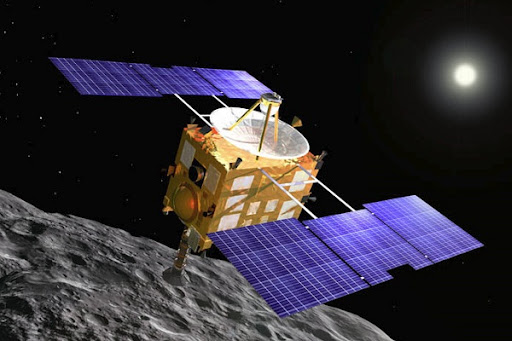The Japanese Hayabusa space probe, which has proven the viability of previously theoretical concepts like ion engines, and tried to capture some material from asteroid 25143 Itokawa, is on the last leg of its journey. The BBC reports:
Hayabusa has achieved a crucial engine firing to aim the probe at Woomera Protected Area in southern Australia.
Its sample return capsule is scheduled to detach from its "mothership" and land at Woomera on 13 June, but there is no guarantee of mission success.Artist's impression of Hayabusa space probe above asteroid 25143 Itokawa
It remains doubtful whether the probe managed to grab any material from Itokawa; scientists will have to open the capsule to find out.
At the weekend, the Japanese Space Agency (Jaxa) announced that Hayabusa had successfully completed its third Trajectory Correction Manoeuvre (TCM), designed to guide the spacecraft towards a touchdown in the Australian outback.
The spacecraft now lies within about 3,600,000km of our planet.
Just one further, more detailed, correction manouevre is planned for the spacecraft before its sample capsule is returned to Earth at around 1400 GMT on Sunday.
The US space agency (Nasa) will deploy a DC-8 plane from California to observe the scheduled landing.
The aircraft is packed with imaging and spectrographic cameras to capture different aspects of the craft's re-entry.Asteroid 25143 Itokawa photographed by Hayabusa space probe
Even if Hayabusa failed to grab large samples at Itokawa, scientists hope the capsule may still contain small residues from the asteroid that could be analysed in laboratories.
Asteroids contain primordial material left over from the formation of the Solar System billions of years ago.
There's more at the link.
The Hayabusa spacecraft has spent many years looping out from Earth towards the asteroid, then back home again (it was launched in 2003). After seven years in the near-abs0lute-zero of space, it'll burn up in the Earth's atmosphere, except (hopefully) for the sample capsule which (hopefully) will bring scientists their first asteroid material for analysis. Here's wishing them luck!
Peter


1 comment:
I do hope it isn't like that vehicle that had the aerogel blocks to collect particles in orbit, that thundered into the desert a few years back.
Jim
Post a Comment